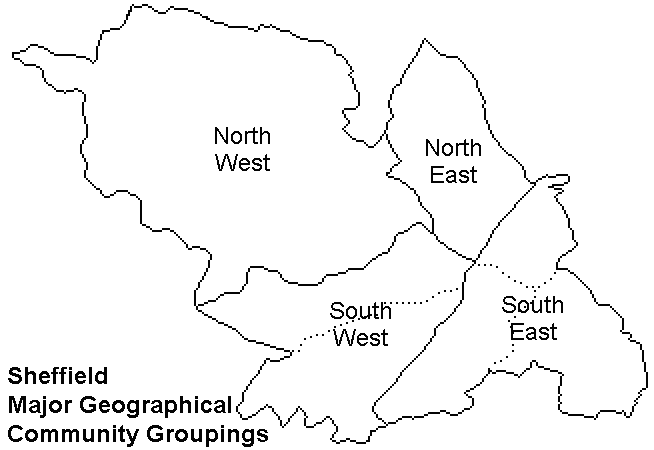Council size and number of wards
NOTE: These numbers are out of date. They need updating with the updated 2020 forecast.
The first stage of a boundary review is decide the size of the council - the number of councillors and the number of wards they represent. Sheffield currently has 28 three-member wards, resulting in 84 councillors. (Two-member wards are now also allowed, but they are not considered in the calculations here.)
While the council size is influenced by how many councillors it is believed would result in effective governance of the city, the size is also necessarily and unavoidably constrained by how feasible it is to fit the wards into the geography of the city and how practical it is for councillors to support the number of electors in their wards.
The four main valleys in Sheffield arrange the city into four major sectors, trying to draw a ward that crosses between these major sectors results in unweildy and impractical groupings of geography and communities. Also, dealing with the four sectors of the city individually means that different models can be changed in different sectors without having any impact on the rest of the city.
This table shows how many 3-member wards would fit into each sector of the city for a range of different total wards, and the current number of wards. (data)
| 
Numbers close to an exact whole number are shown in bold. | ||||||||||||||||||||||||||||||||||||||||||||||||||||||||||||||||||||||||||||||||||||||||||||||||||||||||||||||||||||||||||||||||||||||||||||||||||||||||||||||||||||||||||||||
This shows that the only model that results in each sector having a whole number of wards is a drop to 27 wards and 27*3=81 councillors. This would have to be done by dropping the number of wards in the south-east sector by one from 11 to 10, which would neccesarily have to be done by expanding the southern wards as these are shrinking, while the northern wards are mainly static or increasing.
If it was desired to avoid dropping the number of wards in the south-east sector, that would only be possible by increasing the number of wards in the whole city by one to 29, but by adding 2/3 of a ward to the south-west and 1/3 of a ward to the north-east sector. This would have to be done with three 2-member wards as the geography doesn't allow a full 3-member ward to straddle the south-west/north-east boundary with the required numbers.
The Burngreave/City Centre boundary could be pushed southwards from the railway line to the River Don, adding maybe up to about 500 electors to the North-East sector, but this is the opposite direction to what would be needed, and there is no workable way that it could be pushed in this direction.
A drop to fewer than 27 wards would result in fractional ward sizes all over the city, as well as significantly increase the electorate in each ward. Sheffield has historically always had in the region of 27-30 3-member wards, and through changing local government structures, administration and responsibilities, this has worked as the right sort of size for the council. IF a different council size is desired, THEN fractional ward sizes ARE forced onto the model.
Outline summary of a range of council sizes
| 30 wards: NW: 3 wards NE: 6+2/3 wards SW: 9 wards SE: 11+1/3 wards electorate: 13,500 | This would require two-thirds of a ward from the north-east sector to cross the Lower Don Valley and join with one-third of a ward in the south-east sector. This would require very arbitary slicing up of the Wincobank and Darnall areas. Alternatively, one 2-member ward in the north-east and two 2-members wards in the south-east. |
| 29 wards: NW: 3 wards NE: 6+1/3 wards SW: 8+2/3 wards SE: 11 wards electorate: 13,900 | This would require slicing one-third of a ward out of the Burngreave area in the north-east sector to add to the City Centre in the south-west sector. Alternatively, two 2-member wards in the north-east and one 2-member ward in the south-west. |
| 28 wards: NW: 3 wards NE: 6 wards SW: 8+1/3 wards SE: 10+2/3 wards electorate: 14,400 | This would require one-third of a ward from the south-west sector to be added to the south-east sector. This may be workable in the City Centre area with a ward that crosses the railway line and extends to include the area just east of the City Centre. |
| 27 wards: NW: 3 wards NE: 6 wards SW: 8 wards SE: 10 wards electorate: 15,000 | This is the only model of a similar size to the existing council that fits into the community geography of the city. |
| 26 wards: NW: 3 wards NE: 5.5 wards SW: 7.5 wards SE: 10 wards electorate: 15,500 | This presents a worse case than the 29-ward model as even more has to be sliced out of Burngreave to be added to the south-west sector. With half-ward sizes it is not possible to arrange the numbers with some 2-member wards. |
| 25 wards: NW: 2.5 wards NE: 5.5 wards SW: 7.5 wards SE: 9.5 wards electorate: 16,200 | This model is is even worse than a 26-seat model, it requires half wards in every sector of the city, and would not even be possible with scatterings of 2-member wards. |